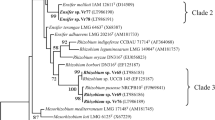Abstract
Three novel endophytic rhizobial strains (RRE3, RRE5, and RRE6) were isolated from naturally growing surface-sterilized rice roots. These isolates had the ability to nodulate common bean (Phaseolus vulgaris). Polymerase chain reaction–restriction fragment length polymorphism (PCR-RFLP) and sequencing of 16S rDNA of these isolates revealed that RRE3 and RRE5 are phylogenetically very close to Burkholderia cepacia complex, whereas RRE6 has affinity with Rhizobium leguminosarum bv. phaseoli. Plant infection test using gusA reporter gene–tagged construct of these isolates indicated that bacterial cells can go inside and colonize the rice root interiors. A significant increase in biomass and grain yield was also recorded in greenhouse-grown rice plants inoculated with these isolates.

Similar content being viewed by others
Literature Cited
Altschul SF, Madden TL, Schaffer AA, Zhang J, Zhang Z, Miller W, Lipman DJ (1997) Gapped BLAST and PSI-BLAST: a new generation of protein database search programme. Nucleic Acids Res 25:3389–3402
Biswas JC, Ladha JK, Dazzo FB, Yanni YG, Rolfe BG (2000a) Rhizobial inoculation influences seedling vigor and yield of rice. Agron J 92:880–886
Chaintreuil C, Giraud E, Prin Y, Lorquin J, Ba A, Gillis M, de Laudie P, Dreyfus B (2000) Photosynthetic bradyrhizobia are natural endophyte of the African wild rice Oryza breviligulata. Appl Environ Microbiol 66:5437–5444
Chen W-M, Laevens S, Lee T-M, Coenye T, DeVos P, Mergeay M, Vandamme P (2001) Ralstonia taiwanensis sp. nov., isolated from root nodules of Mimosa species and sputum of a cystic fibrosis patient. Int J Syst Evol Bacteriol 51:1729–1735
Coenye T, Vandamme P, Govan JRW, LiPuma JJ (2001) Taxonomy and identification of the Burkholderia cepacia complex. J Clin Microbiol 39:3427–3436
Fahraeus G (1957) The infection of clover root hairs by nodule bacteria studied by a simple glass slide technique. J Gen Microbiol 16:374–381
Laguerre G, Allard MR, Revoy F, Amarger N (1994) Rapid identification of rhizobia by restriction fragment length polymorphism analysis of PCR-amplified 16S rRNA genes. Appl Environ Microbiol 60:56–63
Lorenz MG (1998) Horizontal gene transfer among bacteria in soil by natural genetic transformation. In: Subba Rao NS, Dommergues YR (eds) Microbial interactions in agriculture and forestry, vol. 1. New Delhi, India: Oxford and IBH Publications, pp 19–44
Ludwig W, Amann R, Martinez-Romero E, Schonhuber W, Bauer S, Neef A, Schleifer K-H (1998) rRNA based identification and detection systems for rhizobia and other bacteria. Plant Soil 204:1–19
Matiru VN, Dakora FD (2004) Potential use of rhizobial bacteria as promoters of plant growth for increased yield in land races of African cereal crops. African J Biotechnol 3:1–7
Moulin L, Munive A, Dreyfus B, Boivin-Masson C (2001) Nodulation of legumes by members of the β-subclass of proteobacteria. Nature (London, UK) 411:948–950
Peng S, Biswas JC, Ladha JK, Gyaneshwar P, Chen Y (2002) Influences of rhizobial inoculation on photosynthesis and grain yield of rice. Agron J 94:925–929
Perrine FM, Prayitno J, Weinman JJ, Dazzo FB, Rolfe BG (2001) Rhizobium plasmids are involved in the inhibition or stimulation of rice growth and development. Aust J Plant Physiol 28:923–937
Reddy PM, Ladha JK, So RS, Hernandez RJ, Ramos MC, Angeles OR, Dazzo FB, de Bruijn FJ (1997) Rhizobial communication with rice roots: induction of phenotypic changes, mode of invasion and extent of colonization. Plant Soil 194:81–98
Sambrook J, Russell DW (2001) Molecular cloning: A laboratory manual. Vol. 1, 3rd edn. New York: Cold Spring Harbor Laboratory Press (http://www.molecularcloning.com)
Tan Z, Hurek T, Vinuesa P, Muller P, Ladha JK, Reinhold-Hurek B (2001) Specific detection of Bradyrhizobium and Rhizobium strains colonizing rice (Oryza sativa) roots by 16S-23S ribosomal DNA intergenic spacer-targeted PCR. Appl Environ Microbiol 67:3655–3664
Vandamme P, Goris J, Chen W-M, De Vos P, Willems A (2002) Burkholderia tuberum sp. nov. and Burkholderia phymatum sp. nov. nodulate the roots of tropical legumes. Syst Appl Microbiol 25:507–512
Vauterin L, Vauterin P (1992) Computer-aided objective comparison of electrophoresis patterns for grouping and identification of microorganisms. Eur Microbiol 1:37–41
Verma SC, Ladha JK, Tripathi AK (2001) Evaluation of plant growth promoting and colonization ability of endophytic diazotrophs from deep water rice. J Biotechnol 91:127–141
Verma SC, Chaudhari SP, Tripathi AK (2004) Phylogeny based on 16S rDNA and nifH sequences of Ralstonia taiwanensis strains isolated from nitrogen fixing nodules of Mimosa putida, in India. Can J Microbiol 50:313–322
Weisburg WG, Barns SM, Pelletier DA, Lane DJ (1991) 16S ribosomal DNA amplification for phylogenetic study. J Bacteriol 173:697–703
Yanni YG, Rizk RY, Corich V, Squartini A, Ninke K, Philip-Hollingsworth S, Orgambide G, de Bruijn FJ, Stoltzfus J, Buckley D, Schmidt TM, Mateos PF, Ladha JK, Dazzo FB (1997) Natural endophytic association between Rhizobium leguminosarum bv. trifolii and rice roots and assessment of its potential to promote rice growth. Plant Soil 194:99–114
Yanni YG, Rizk RY, El-Fattah FKA, Squartini A, Corich V, Giacomini A, de Bruijn FJ, Rademaker JL, Maya-Flores J, Ostrom P, Vega-Hernandez M, Hollingsworth RI, Martinez-Molina E, Mateos P, Velazquez E, Wopereis J, Triplett E, Umali-Garcia M, Anarna JA, Rolfe BG, Ladha JK, Hills JH, Mujoo R, Ng KP, Dazzo FB (2001) The beneficial plant growth-promoting association Rhizobium leguminosarum bv. trifolii with rice plants. Aust J Plant Physiol 28:845–870
Zakhia F, Jeder H, Domergue O, Willems A, Cleyet-Marel J-C, Gillis M, Dreyfus B, De Lajudie P (2004) Characterization of wild Legume Nodulating Bacteria (LNB) in infra-arid zone of Tunisia. Syst Appl Microbiol 27:380–395
Acknowledgments
This work is a part of Ph.D. research of Mr. R.P.N. Mishra, which was supported by a BHU research scholarship from the University. The authors are very thankful to Dr. Peter van Berkum, USDA, USA for 16S rDNA sequencing and for providing USDA 2695 strain and to Prof. Barry G. Rolfe, ANU, Australia for providing ANU 843. The authors acknowledge financial support from the Department of Science and Technology, Government of India.
Author information
Authors and Affiliations
Corresponding author
Rights and permissions
About this article
Cite this article
Singh, R.K., Mishra, R.P., Jaiswal, H.K. et al. Isolation and Identification of Natural Endophytic Rhizobia from Rice (Oryza sativa L.) Through rDNA PCR-RFLP and Sequence Analysis. Curr Microbiol 52, 345–349 (2006). https://doi.org/10.1007/s00284-005-0138-3
Received:
Accepted:
Published:
Issue Date:
DOI: https://doi.org/10.1007/s00284-005-0138-3




